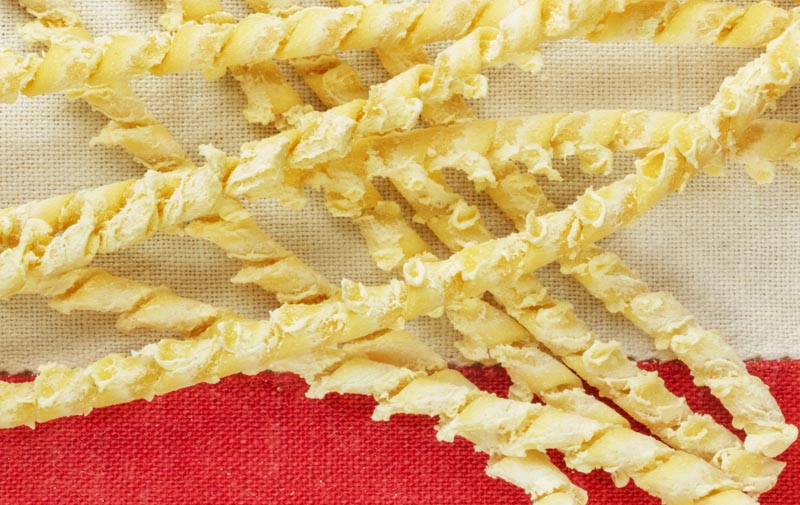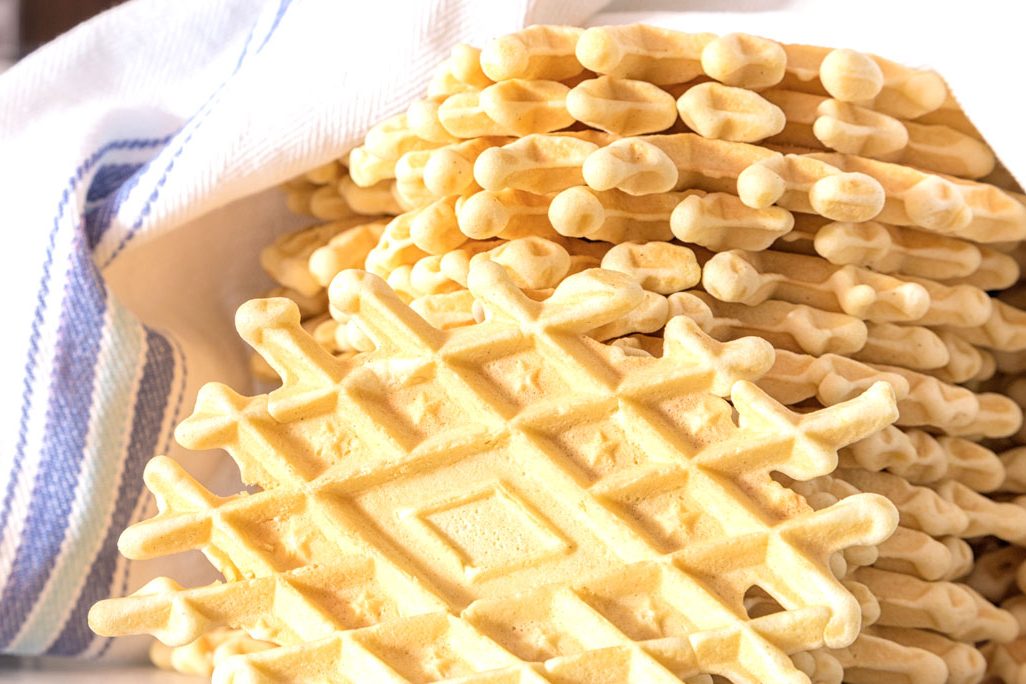This is one your Sicilian nonna used to make. Also known as maccaruna di casa, busiate are made of durum wheat and water, and are perhaps Sicily’s most famous pasta lunga. The deft hands of the Sicilian women can turn these out with utterly astonishing speed. Knobs of dough are formed into ropes and rolled around a ferretto, or thin iron rod, something like a knitting needle.
Some of the finest busiate are made by Molini del Ponte. The company uses an heirloom durum wheat, a variety indigenous to Sicily known as Tumminia. This is not a pasta that you see in most American markets, but this spring Beatrice Ughi, owner and founder of Gustiamo (Gustiamo.com), one of New York’s premier Italian food specialty shops, brought this unique pasta to our shores.
Of the pasta maker Beatrice says “Filippo Drago is one of the most passionate farmers and producers I’ve ever met. And stubborn, too. It took him ten years to grow a decent quantity of Tumminia, which was in danger of extinction. Filippo stone mills the flour in his own mill and the busiate pasta is made by a small artisanal pastificio near him, in Castelvetrano. The pasta is dark in color, it’s very tasty and easy to digest. Grazie Filippo!”
Serve this with Pesto Trapanese, one of Sicily’s traditional pounded nut sauces. The condimento, heavy with the flavors of garlic, basil, and almonds, is one of the delights of island cuisine. Food writer Nancy Harmon Jenkins ( NancyHarmonJenkins.com ) writes that this sauce is also known as agliata trapanese or agghiata trapanisa. She recommends that it be topped with toasted bread crumbs rather than cheese. Having tried this dish both ways, I am now firmly in Ms. Harmon Jenkins’ corner.
Busiate col Pesto Trapanese
For a real Sicilian experience, use a Sicilian oil such as Pianogrillo, along with Sicilian salt and almonds from Noto. Whether you make this pesto in a food processor or with the traditional mortar and pestle, the goal is to make a thick, somewhat chunky emulsion. The pesto may be held at room temperature for two hours. Refrigerate for longer storage, bringing it to room temperature prior to dressing the busiate.
•1 pound busiate
•5 tomatoes, peeled, seeded, and well chopped
•2 garlic cloves, peeled
•A handful of large basil leaves
•½ cup whole almonds, blanched and lightly toasted
•Peperoncino flakes
•Sea salt
•Extra virgin olive oil
•Pecorino or ¼ cup dry white bread crumbs
Place the chopped tomatoes in a colander and sprinkle with ½ teaspoon salt. Set aside to drain.
To blanch the almonds, fill a 2-quart saucepan half full with water and bring to a boil. Drop the almonds in and boil 30 seconds. Drain in a colander. Release the skins by holding the nut between your thumb and forefinger, pressing on the rounded end of the nut and giving a gentle squeeze. Discard the skins and set the almonds aside to dry thoroughly.
To toast the almonds, preheat the oven to 350 degrees F. Spread the dried, blanched almonds on a cookie sheet. Toast on center rack 10 minutes until lightly colored and mildly fragrant. The nuts will release some of their oil, developing an enticing sheen. Do not toast the almonds darkly or they will impart an unpleasant bitter taste to the pesto. Remove the nuts from the oven and set aside to cool. If you are going to use a mortar and pestle to make the pesto, chop the nuts finely. If you will be using a food processor for the pesto, the almonds may be left whole.
To make the pesto in a food processor: place drained tomatoes, garlic, almonds, basil, ¼ teaspoon peperoncino flakes, and ½ teaspoon sea salt in the workbowl of a processor fitted with the steel blade. Process to a coarse paste. Turn the machine on, remove the feed tube and slowly add 4 tablespoons of olive oil, blending well. Taste for seasoning, adding more salt or peperoncino, if desired.
To use a mortar and pestle: grind the garlic and salt together to form a paste. Crush the basil leaves into the garlic paste. Add ½ teaspoon sea salt and ¼ teaspoon peperoncino flakes. Blend well. Add the tomatoes in 4 additions, blending until thick, yet still chunky. Add the chopped almonds. Slowly add ¼ cup of olive oil in a thin stream, mixing constantly. Check for seasoning.
If using the bread crumbs, heat 2 tablespoons of olive oil in a small skillet. Add the bread crumbs and toast until light golden, stirring frequently to prevent burning. Turn bread crumbs out of the skillet to prevent scorching. Set aside.
Bring 6 quarts of water to a rolling boil. Add 1 tablespoon of sea salt. Add busiate and cook about 10 to 11 minutes. Transfer pesto to a warmed bowl. Drain the busiate, reserving about 1 cup of the cooking water. Drop the cooked busiate onto the pesto, tossing to coat. Add pasta water, a tablespoon at a time, if necessary, to loosen the sauce. Serve at once topped with grated cheese or toasted breadcrumbs.
Busiate, Sicilian oils, nuts and salt are available from Gustiamo.com
Questions? Email me at adri@AdriBarrCrocetti.com or visit at AdriBarrCrocetti.com































